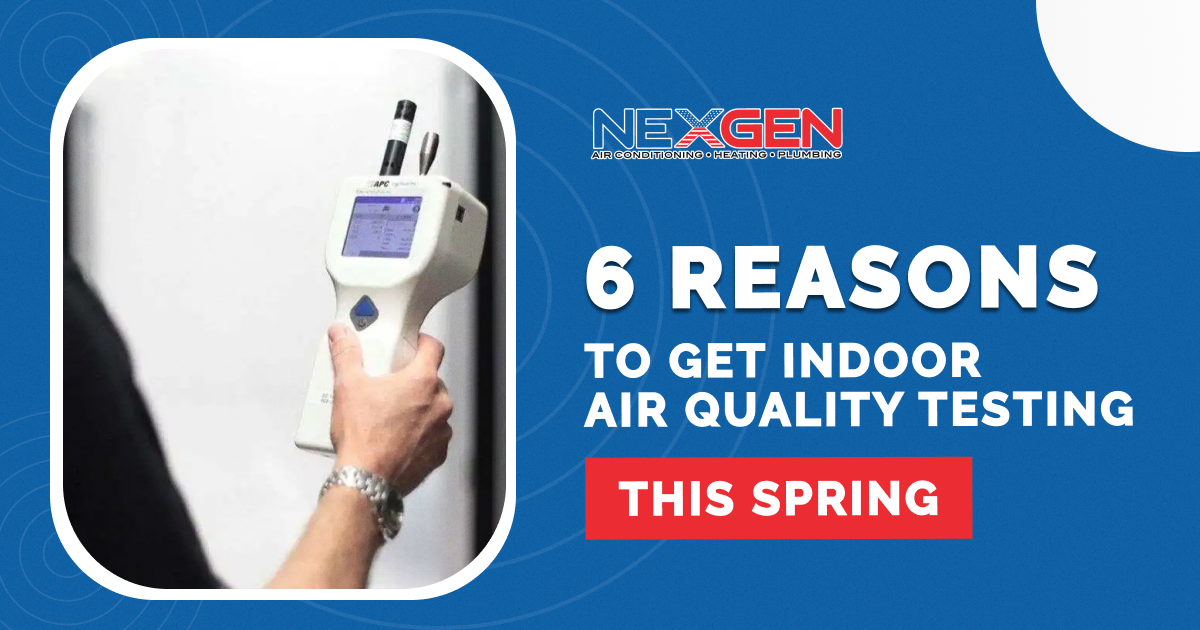6 Reasons to Get Indoor Air Quality Testing This Spring

We often see springtime as a relief from the harshness of winter. It is also a time when activities, such as leaving the windows open or getting a deep cleaning done, can affect indoor air quality. Indoor air pollution can trigger allergies, worsen asthma, and cause headaches, nausea, coughing, sneezing, irritation, fatigue, and a host of other symptoms.
With indoor air quality testing, you can learn whether your symptoms are occurring for the following reasons:
1. Pollen Is in the Air
In most parts of the U.S., pollen counts soar in the spring. Trees, shrubs, grass, and flowers release pollen, which triggers a chain reaction in the body that causes allergies. Keeping your air conditioner filters clean or installing windowless ACs can help. Professional testing can determine if pollen, and what type, is affecting your home, so you can implement the best measures to reduce it. The best solutions are those that keep the pollen out of your home; regular vacuuming or installing air purifiers or high-efficiency particulate air (HEPA) filters can help.
2. Biological Pollutants
In addition to pollen, numerous biological pollutants can cause poor air quality in your home. Testing for mold, viruses, and toxins from microorganisms can help determine what steps to take. Mold spores are present indoors and outdoors and can stick to just about anything. When mold grows, it can cause respiratory issues even in healthy people. Testing is a good idea especially if you see visible mold; so you can take the appropriate actions.
Dust mites are another biological pollutant that can be reduced by keeping indoor humidity levels below 50%. You can also put impermeable covers over your mattress and pillows, and washing bedding in hot water. Removing dust with a damp rag and allergens with a vacuum can get rid of them as well.
3. Chemical Pollutants
Household products such as cleaners, disinfectants, paints, stored fuels, wood preservatives, furnishings can emit vapors and gases. Within these gases, volatile organic compounds (VOCs) can be often be found. These VOC’s are extremely toxic and cause a wide range of symptoms as well as organ damage.
Testing for VOCs should be done by an accredited lab to ensure accurate results. You can often reduce VOCs by increasing ventilation, discarding old chemicals, and using products as directed by the manufacturer. Some particularly concerning compounds include benzene, a known carcinogen found in paints, fuel products, and tobacco smoke, as well as perchloroethylene and formaldehyde.
4. Combustion Pollutants
Many people don’t realize the abundance of combustion pollutants in their homes. Environmental tobacco smoke, or secondhand smoke, contains thousands of potentially harmful compounds. It has resulted in thousands of deaths among non-smoking adults and respiratory conditions in children. Parents who smoke unknowingly put their kids at risk.
Carbon monoxide (CO) is also a combustion pollutant. The colorless, odorless gas prevents the blood from absorbing oxygen and, in high concentrations, can be deadly. It can originate from unvented space heaters, fireplaces, woodstoves, and gas stoves as well as damaged or poorly maintained furnaces. While air quality testing can help detect CO, the U.S. Consumer Product Safety Commission (CPSC) recommends use of UL-approved carbon monoxide alarms and regular inspection of fuel-burning appliances.
5. Radon
A radioactive gas, radon occurs naturally in soil and can move up from the ground, through cracks and holes in a foundation, and into your home. Breathing in radioactive particles can cause lung tissue damage and, in some people, lung cancer. The U.S. Environmental Protection Agency recommends testing for radon in any home below the third floor, starting with a short-term test and another after a high result. A long-term test can provide a clearer perspective of radon levels present year-round. If radon is high in your home, you can install a vent pipe and fan to address the problem.
6. Indoor Air Pollution Can Make You Sick
In addition to allergies, asthma, and irritated eyes and throats, there are even more greater health concerns associated with indoor air pollution. High levels of lead can cause convulsions, coma, and death, but long-term exposure to low levels can cause central nervous system and brain damage; it can harm the kidneys and blood cells as well. In children, it can lead to a shorter attention span, behavioral problems, and a lower IQ.
The effects of mold, tobacco smoke, carbon monoxide, and VOCs are well-known. For the health of your family, it is important to consider indoor air quality testing if you haven’t done so already. The everyday cleaning products you use may be putting your health at risk as well. These are just a few important considerations to think about this spring.
Trust Nexgen for Air Quality Testing and Improvements
The leading HVAC company in Southern California, we can help with indoor air quality testing and provide effective improvements to deal with common pollutants. Our HVAC technicians are familiar with the latest solutions. We guarantee quality and competitive pricing as well. To learn more about our indoor air quality services and schedule an appointment, call 833-729-9735 today.





















